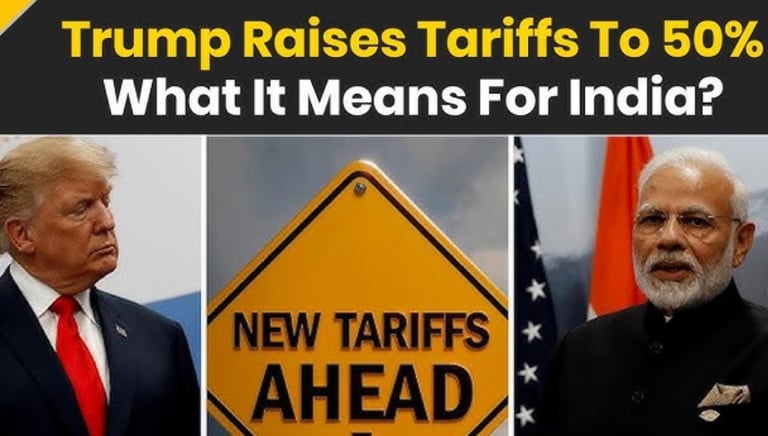Trump’s 50% Tariff on Indian Imports: What It Means for Trade, Economy, and You
U.S. President Donald Trump made headlines once again by imposing a hefty 50% tariff on Indian imports, marking one of the most significant moves in the two countries’ recent trade history. The decision, justified by Washington as a response to “national security concerns,” has sent ripples through diplomatic circles, rattled exporters, and raised questions about the future of U.S.–India trade relations.
flixah developers
8/12/20255 min read


Trump’s 50% Tariff on Indian Imports: What It Means for Trade, Economy, and You
In August 2025, U.S. President Donald Trump made headlines once again by imposing a hefty 50% tariff on Indian imports, marking one of the most significant moves in the two countries’ recent trade history. The decision, justified by Washington as a response to “national security concerns,” has sent ripples through diplomatic circles, rattled exporters, and raised questions about the future of U.S.–India trade relations.
But what exactly happened, why was this decision taken, and what does it mean for businesses, consumers, and the broader economy? Let’s unpack the full story.
Background: A Complex U.S.–India Trade Relationship
India and the United States have long shared a multi-layered relationship — politically friendly, strategically aligned in several areas, but also prone to occasional friction in trade.
Historically, the U.S. has been one of India’s largest trading partners, with bilateral trade touching $191 billion in 2024. India’s exports to the U.S. include a wide range of goods such as electronics, textiles, jewelry, pharmaceuticals, machinery, and IT services. The U.S., in return, exports aircraft, defense equipment, oil, and agricultural products to India.
This relationship has generally been cooperative. However, the Trump administration has consistently emphasized “America First” trade policies, aiming to reduce trade deficits and bring manufacturing jobs back to U.S. soil. India, with its competitive pricing and growing export share, often found itself in the crosshairs of such policies.
The Trigger: Russian Oil Imports and Strategic Concerns
The official reason cited for the new tariffs is India’s continued purchase of discounted Russian oil despite U.S. pressure to reduce such imports. Washington argues that these purchases indirectly support Russia’s economy amid ongoing geopolitical tensions.
From the Trump administration’s perspective:
Economic leverage: Using tariffs as a bargaining chip to influence India’s foreign policy choices.
National security argument: Positioning the move as a stand against financial flows that could strengthen U.S. adversaries.
Political optics: Signaling toughness to the domestic voter base ahead of upcoming political cycles.
For India, buying discounted oil from Russia has been primarily an economic decision — lowering energy costs, controlling inflation, and supporting industrial production. However, this pragmatic approach has now become a flashpoint in trade relations.
The Tariff: Scope and Impact
As of August 8, 2025, a 50% tariff is applied to all Indian goods entering the U.S., with no exceptions or phased implementation. This is an unusually steep hike — far higher than the 5–15% tariffs typically seen in global trade disputes.
Industries Most Affected
Electronics and Machinery
Smartphones, laptops, industrial equipment, and components face significant price jumps.
Indian electronics exporters are already seeing cancellations from U.S. buyers.
Textiles and Apparel
Cotton garments, silk products, and home furnishings could become 30–40% more expensive for U.S. consumers.
Smaller Indian textile businesses may lose market share to competitors from Vietnam and Bangladesh.
Jewelry and Gems
India, a global hub for diamond cutting and gold jewelry, may see reduced orders from American retailers due to higher import costs.
Automobile Components
India’s auto parts industry, a major supplier to U.S. carmakers, faces margin pressures as tariffs erode competitiveness.
Agricultural and Processed Foods
Indian spices, rice, tea, and packaged foods will now cost much more in U.S. supermarkets, potentially reducing demand.
Short-Term Economic Consequences
The immediate effect of this tariff is higher prices for U.S. consumers and shrinking profit margins for Indian exporters.
For U.S. buyers: Importers may either absorb some costs (reducing profits) or pass them on to consumers (raising retail prices). Either way, affordability suffers.
For Indian exporters: Many contracts signed before the tariff now operate at a loss unless renegotiated. Smaller exporters, who lack the buffer to absorb losses, face financial strain.
For the Indian economy: Sectors heavily dependent on the U.S. market could see reduced output, layoffs, and liquidity crunches.
Diplomatic Fallout
India’s Ministry of Commerce has called the move “unjustified” and hinted at retaliatory tariffs on U.S. goods. Potential counter-measures may include higher duties on American agricultural products, wines, and technology imports.
However, both nations are aware that an all-out trade war could harm strategic cooperation in defense, technology, and climate initiatives. Behind the scenes, negotiations are ongoing, but public rhetoric remains firm.
Long-Term Strategic Shifts
If the tariff remains in place for an extended period, expect several long-term adjustments in trade patterns:
Diversification of Markets
Indian exporters may accelerate efforts to expand into Europe, the Middle East, and Southeast Asia to reduce dependence on the U.S.Supply Chain Reconfiguration
Some Indian companies might consider setting up manufacturing or assembly units in countries with lower tariffs to maintain U.S. market access.Rise of Alternate Suppliers in the U.S.
U.S. retailers and manufacturers may increase sourcing from tariff-free nations like Vietnam, Mexico, or the Philippines.Push for Domestic Consumption in India
Industries hit by the loss of U.S. orders may turn towards India’s growing middle class for sales.
Global Perspective
This tariff is not an isolated incident. The Trump administration has been implementing 15%–50% tariffs on imports from several countries, including Brazil and China. The approach signals a broader shift towards protectionism, challenging decades of global trade liberalization.
For other countries watching this development, it’s a reminder that political decisions can rapidly reshape economic realities, forcing businesses to build resilience and flexibility.
What Businesses Can Do Now
For Indian exporters:
Renegotiate Contracts: Factor in tariff costs and currency fluctuations when dealing with U.S. buyers.
Seek Alternate Markets: Explore regions with free trade agreements or lower tariff exposure.
Invest in Branding: Higher prices are easier to justify for premium, branded products rather than generic goods.
Consider U.S.-Based Operations: Setting up assembly or warehousing in the U.S. may help bypass some tariff costs.
For U.S. importers:
Stockpile Inventory: Secure orders before further tariff hikes or retaliation occur.
Diversify Suppliers: Build a multi-country supply chain to reduce dependency on any single market.
Explore Substitutes: Assess local production feasibility for goods currently imported from India.
The Road Ahead
While a 50% tariff is a severe blow, trade disputes often evolve. Political negotiations, business lobbying, and economic realities can all influence the timeline for tariff reduction or removal. For now, however, both Indian exporters and U.S. consumers will need to adjust to a new pricing landscape.
Ultimately, whether this move strengthens U.S. manufacturing or simply disrupts global trade remains to be seen. What’s clear is that in today’s interconnected economy, no tariff exists in isolation — it sends ripples across borders, industries, and even dinner tables.
Conclusion
The Trump administration’s 50% tariff on Indian imports is more than just a trade policy; it’s a geopolitical signal, an economic challenge, and a test of resilience for both nations’ businesses. While the pain is immediate for exporters and consumers, the long-term impact will depend on how swiftly and strategically both countries can find common ground.
For now, the message to businesses is clear: adapt, diversify, and prepare for a world where trade rules can change overnight.
